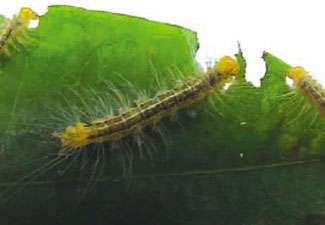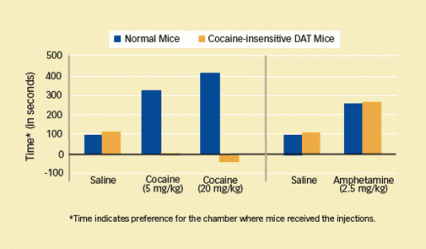NIDA researchers have desensitized mice to cocaine by genetically altering their dopamine transporters—proteins that are a key target of cocaine—to resemble ones found in the brains of some insects. If investigators can identify a compound that alters these transporters in the same manner, they might be one step closer to developing medications to treat cocaine addiction.
A South American caterpillar started the researchers on their path to the discovery. Larvae of the Eloria noyesi moth have a particular appetite for leaves of the coca plant. This preference has captured the interest of drug-control authorities, who view the caterpillar as a potential tool for eradication of coca crops. To Dr. Howard Gu at Ohio State University (OSU), however, the caterpillar's apparent immunity to the psychoactive properties of the coca leaf suggested something else: Perhaps cocaine's target protein in the caterpillar's brain—the dopamine transporter (DAT)—does not respond to the leaf. If so, he reasoned, an understanding of how the insect's DAT functions might provide a template for pharmacological agents to block the effects of the coca leaf's potent derivative, cocaine.
 Food Not Drug: A coca leaf—the source of cocaine—is just food to the South American caterpillar Eloria noyesi. Like some other insects, its dopamine transporters are much less sensitive to cocaine than those of mice.
Food Not Drug: A coca leaf—the source of cocaine—is just food to the South American caterpillar Eloria noyesi. Like some other insects, its dopamine transporters are much less sensitive to cocaine than those of mice.Scientists generally believe that cocaine produces its high by preventing DATs from regulating dopamine levels in the brain's reward system, resulting in a euphoria-producing buildup of the neurotransmitter in the nucleus accumbens (NAc). If an animal reliant on coca for nutrition were to be subject to this effect, however, surges of euphoria would occur whenever it ate and presumably be very disruptive of its functioning. "Because the caterpillar is interested in coca leaves as a food source, we hypothesized that its DATs might not interact with cocaine," Dr. Gu says.
A Surprising Twist
Dr. Gu undertook a 10-year project that ultimately established a mutated form of DAT that is cocaine-insensitive. But he encountered several surprising twists—and frustrating letdowns—along the way.
Chief among these, Dr. Gu was disappointed to find that the DAT from Eloria is not substantially less sensitive to cocaine than the DAT from other insects they tested, such as a silkworm that does not eat coca leaves. He quickly recognized that there was nothing unique about the Eloria caterpillar in this regard and was forced by that evidence to relinquish the elegant evolutionary theory he had held about how its insensitivity to the stimulating effects of the coca leaf might have developed.
But what he learned in the process was more important than a busted theory: Dr. Gu discovered that the DATs from a number of insect species are just 5 percent as sensitive to cocaine as is mouse DAT. "I seized on the difference to generate clues about how to alter the mouse DAT to be cocaine-insensitive like the insects'," he says.
As a first step, Dr. Gu switched fragments of insect DAT sequences with mouse DAT sequences and identified key regions that affect how tightly cocaine binds to the DAT protein. He then randomly generated a large number of alterations in these regions of the mouse DAT sequence. Working with cultured cells, he tested them one by one to see if the changes they introduced would desensitize mouse DAT to cocaine. Through this laborious process, he eventually identified the sequence changes that make the transporter cocaine-resistant.
Dr. Gu created mutant mice with the same DAT sequence changes. The mutant mice produced cocaine-resistant DAT. But were the animals truly immune to the rewarding sensations of the drug? Dr. Gu joined with colleagues at OSU and the University of Tennessee College of Medicine to answer this question.
Selective Indifference
When normal mice are exposed to cocaine in one compartment of a split cage, they demonstrate liking for the drug by later spending the bulk of their time in that compartment. The proportion of time the animals spend in the drug-associated compartment provides a quantitative behavioral measure of the intensity of the drug's rewarding effects. In Dr. Gu's trials, the mutant mice spent no more time in a cage area where they received the injections of cocaine (5 mg/kg or 20 mg/kg) than they did in a compartment where they were given saline injections—a clear demonstration that they were not experiencing cocaine's rewarding effects (see graph below, left panel).
To ensure that the mutant mice retained normal responses to stimuli other than cocaine, the researchers gave them amphetamine. This stimulant triggers dopamine surges by mechanisms different from those that cocaine triggers. The researchers found that both mutant and normal mice developed elevated extracellular dopamine in the NAc after amphetamine exposure. In addition, the mutants exhibited as much behavioral evidence of amphetamine reward as did a comparison group of normal mice (see graph below, right panel).
"The mutants' response to amphetamine demonstrated that the neural machinery works properly in these animals, and they are not generally deficient in drug-induced reward," says Dr. Gu.
 Mice With Mutated Dopamine Transporters Get No Kick From Cocaine: Normal mice spent more time in a chamber where they had received cocaine injections than in one where they had received saline. But mice with a cocaine-insensitive dopamine transporter (DAT) showed no preference (left panel). In contrast, both normal mice and those with an insensitive DAT lingered in the amphetamine-paired chamber longer than saline-treated animals (right panel).
Mice With Mutated Dopamine Transporters Get No Kick From Cocaine: Normal mice spent more time in a chamber where they had received cocaine injections than in one where they had received saline. But mice with a cocaine-insensitive dopamine transporter (DAT) showed no preference (left panel). In contrast, both normal mice and those with an insensitive DAT lingered in the amphetamine-paired chamber longer than saline-treated animals (right panel).Dr. Gu's team is now seeking to identify a chemical compound that will prevent human DATs—like the mouse's altered DAT—from responding to cocaine. Such a compound would eliminate the drug high and limit the frequency and length of relapses. Yet it would not interfere with the DAT's ability to regulate dopamine, which produces feelings of reward and motivation vital for life-promoting activities, such as eating. NIDA is supporting research to screen for such compounds with a protocol and cell lines provided by Dr. Gu.
A Theory Bolstered
Beyond yielding leads for medication development, Dr. Gu's findings alleviate doubts that have arisen about the strategy of selective DAT desensitization to reduce cocaine reward. In some studies, animals continued to exhibit dopamine surges and behavioral responses to cocaine despite having been genetically altered to lack DAT.
"The results from mice without DAT represented a milestone in cocaine research—it was remarkable that these mice still experienced a high from cocaine," explains Dr. Gu. "In view of that observation, it is reasonable to question the approach of finding compounds that prevent cocaine from binding to the DAT as a therapeutic strategy for cocaine abuse. The results from our mutant mice, however, indicate that DAT altering can block cocaine reward."
In light of their work with the mutants, the researchers now attribute the persistence of cocaine response in DAT-less mice to adaptation. "The brains of DAT knock-out mice seem to undergo significant adaptive neurobiological changes that alter how cocaine produces its effects," says Dr. Gu.
"Dr. Gu and colleagues have verified decisively that cocaine's inhibition of DAT is necessary for its behavioral effects, answering an important question in addiction research," says Dr. Nancy Pilotte of NIDA's Division of Basic Neuroscience and Behavioral Research. She notes, however, that the strong confirmation of DAT's role in cocaine reward does not rule out the idea of redundant systems. "If the dopamine system is damaged, as it is in the DAT-less mice, the brain may 'train' norepinephrine and serotonin neurons to take over reward and other functions," she says.
Source
Chen, R., et al. Abolished cocaine reward in mice with a cocaine-insensitive dopamine transporter. Proceedings of the National Academy of Sciences 103(24):9333-9338, 2006. [Full Text (PDF, 709KB)]
